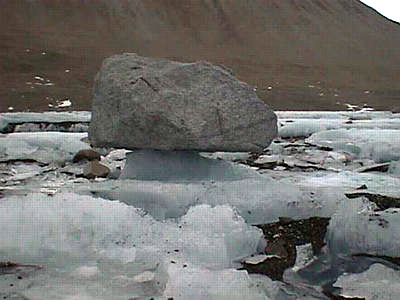
|
Disappearing Rocks data | hook | main | background & resources | student Elissa Elliott, TEA 1998/1999, bruingirl91@hotmail.com Overview
Ventifact research, pictures, lesson, resource compilations are by Elissa Elliott. Activity idea adapted from Windows to the Universe web site. Grade Level/Discipline Time Frame Engagement and Exploration (Student Inquiry Activity) Hand out the Student Lab Sheet. Explain the procedure to the students. Encourage them to predict what will happen to each rock (or mineral) and the extent to which something will happen. Surfaces react differently to forces. After students are done with the activity, ask a spokesperson to record the results on a class overhead or on a class chart on the board. Have the remaining lab partners answer the analysis questions. Explanation (Discussing) Go over the answers to the questions. 1) This will be your hardest rock/mineral (whatever that is). 2) This will be your softest rock/mineral (whatever that is). 3) The softer the rock, the more "washable" it is. The water can tear it apart easier. 4) The shaking in water represented a rainstorm (or pounding under ocean waves) 5) Whenever it rains, the rain causes the soil to move or wash away. The looser the soil, the more it moves. Maybe little streams are formed through the grass; maybe the soil is washed away in certain areas to leave little mounds in your backyard. 6) We used 2 salt pellets to show there is a difference in erosion when the object sizes are different. The larger the surface area, the more erosion. Think of it this way, there’s more area to erode.
7) The rock used to be sitting on the top of a sheet of ice. The wind blew, causing the area around the rock to slowly disappear, leaving the ice under the rock intact and forming a pinnacle.
 (Picture of ice table ventifact) Elaboration (Polar Applications) Another great visual and auditory resource is the Erosion Channel at the Exploratorium (http://www.exploratorium.edu/complexity/exhibit/erosion.html) Most Dry Valley research centering on some form of erosion makes a study of how the glaciers erode and cause erosion (http://quest.arc.nasa.gov/antarctica/background/NSF/valleys.html). Extensions: For a more comprehensive unit, focusing on all types of erosion, I would strongly suggest the following unit plan at http://www.lessonplanspage.com/ScienceSSMDUnitOnErosion46.htm . For other lesson plan ideas, please see the compiled web sites under Resources Exchange (Students Draw Conclusions) Evaluation (Assessing Student Performance) data | hook | main | background & resources | student |
